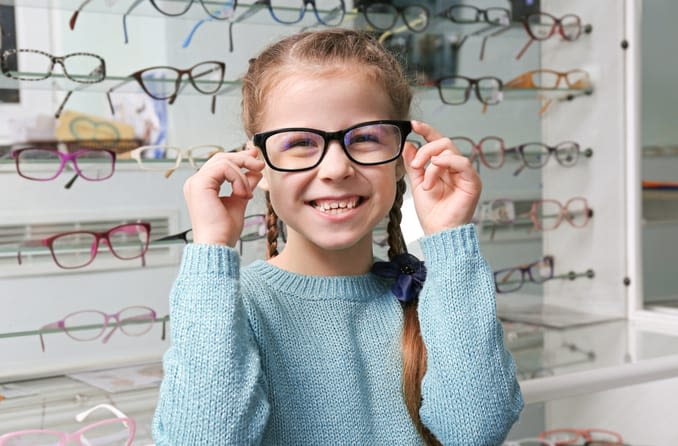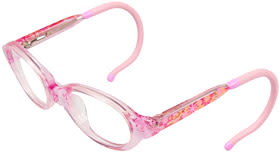Kid's glasses: 10 tips for buying children’s eye-wear

If you're a parent in search of the right pair of glasses for your child, you probably know that walking into an optometrists can be confusing.
There is no shortage of children's frames, the problem is figuring out which glasses your child will want to wear — and will they last longer than the ride home?
Here are 10 shopping tips to help you choose glasses your child will love and that will be stylish and durable.
1. How thick will the lenses be?
The glasses prescription is always the primary consideration in choosing glasses. Before you start looking for the frames, consult with your optometrist about your child's lenses.
If the prescription is stronger than usual , avoid large frames as they will increase the thickness of the lenses. Also, choose high index, aspheric lenses to not only reduce thickness but to ensure lenses give sharp, crisp vision right to the edges of the frame.
2. Choose a modern, attractive style
Most kids will be self-conscious wearing glasses for the first time. So choose frames that have a modern, attractive style. Also, features like photochromic lenses that darken automatically in sunlight outdoors may help inspire your child to want to wear glasses. A study at Clinical Vision Research Australia found 8 out of 10, of a group of 8 to 15 year olds preferred photochromic lenses.
3. Plastic or metal?
Children's frames are made of either plastic or metal and many have styles that intentionally mimic unisex glasses frames designed for adults. Kids often are attracted to these styles because they look more grown-up. It's not unusual for kids to choose glasses that look like those worn by their older siblings or their parents.
In the past, plastic frames were a better choice for children because they were considered more durable, less likely to be bent or broken, lighter in weight and less expensive. Now, manufacturers are making metal frames that incorporate these features as well. Metal composition varies, so ask the optometrist which one is best for your child, based on experience with different alloys.
Choose frames made of hypoallergenic materials if your child has shown sensitivity to certain substances. For example, some people are allergic to metal frames that contain nickel.
4. Proper bridge fit
One of the toughest parts about choosing suitable frames for young children is that their noses are not fully developed, so they don't have a bridge to prevent plastic frames from sliding down. Metal frames, however, usually are made with adjustable nose pads, so they fit everyone's bridge.
Most manufacturers recognise this difficulty with plastic frames and make their bridges to fit small noses.
Each frame must be evaluated individually to make sure it fits the bridge. If any gaps exist between the bridge of the frame and the bridge of the nose, the weight of the lenses will cause the glasses to slide, no matter how well the frame seems to fit before the lenses are added.
It's important that the glasses stay in place; otherwise children tend to look over the top of the lenses instead of pushing their glasses back up where they belong. An optometrist or an optical dispenser is the best judge of whether a frame fits properly.
5. The right temple style

For babies and toddlers, this Dilli Dalli frame called "Half Pint" has cable temples that wrap snugly around the ears to hold eyeglasses in place.
Temples that wrap all the way around the back of the ear help keep glasses from sliding down or dropping off a young child's face completely.
These wrap-around temples, called "curl temples", generally are available on metal frames and are especially helpful to keep glasses in place on toddlers. Another option is a frame that includes an elastic strap that goes around the head.
6. Spring hinges
A nice feature to look for is temples with spring hinges. These allow the temples to flex outward, away from the frames, without causing any damage.
Kids aren't always careful when they put on and take off their glasses, and spring hinges can help prevent the need for frequent adjustments and costly repairs. They also come in handy if the child falls asleep with the glasses on or just has a rough day at play.
Spring hinges also are strongly recommended for toddlers, who sometimes get carried away playing with their new glasses.
7. Lens material
Once you and your child agree on frames that you both like, the next consideration is the lenses.
Children's lenses should be made of polycarbonate or Trivex. These materials are significantly more impact-resistant than other lens materials for added safety.
Polycarbonate and Trivex lenses also are significantly lighter than regular plastic lenses, which makes the glasses more comfortable — especially for strong prescriptions.
And polycarbonate and Trivex lenses have built-in protection against potentially damaging ultraviolet (UV) rays, and the lenses are scratch-resistant coated by the manufacturer or optical lab.
The price for polycarbonate lenses generally is comparable to the cost for regular plastic lenses with UV and scratch-resistant coatings. And with polycarbonate, kids get that extra margin of safety to protect their eyes. Trivex lenses may cost a little more than polycarbonate lenses.
Today, with all the modern lens materials it is generally agrred that glass lenses are unacceptable for for children's spectacles and represent a risk to their eye safety.
8. Sports glasses
Polycarbonate is such a safe lens material that you may be tempted to let your child play sports in his regular glasses.
Here's the drawback: Although polycarbonate is the lens material used for sports eye-wear, regular spectacle frames do not provide enough protection from large objects such as balls and flying elbows.
So if your child is involved in sports, a proper sports frame or goggle with polycarbonate lenses will provide the best protection against eye injury.
To provide optimum protection, sports glasses must be fitted properly — so consult with an eye care professional before purchasing them. The lens openings of sports goggles should be large enough so if the goggles are pushed toward the face, the impact points are above and below the eyes to avoid eye injuries.
9. Warranties

Fun colours and patterns make these new Lucky Brand Kids frames particularly appealing. This frame style, the Willow, can be purchased with engraved fairytale dragons and peace signs.
Check to see if your lenses have a warranty if the lenses become badly scratched from normal wear. Surface scratches can compromise the impact resistance of spectacle lenses, putting your child's eyes at risk.
10. Purchase a "back-up pair"
As children can be tough on their glasses, it's a good idea to purchase a second, or back-up, pair of spectacles for them — especially if your child has a strong prescription and cannot function without his or her glasses.
Ask your optometrist if special discounts apply for second pairs — they often do if the back-up pair is purchased at the same time as the primary pair.
In some cases, sports goggles can be used as a spare pair of glasses. Or, if your child's prescription has not changed significantly, keep his or her previous spectacles in a safe place for use as a spare.
If your child wears glasses full-time, photochromic lenses or prescription sunglasses also should be considered to decrease glare, increase visual comfort and provide 100 percent protection from the sun's harmful UV rays.
Page published on Tuesday, 17 March 2020






